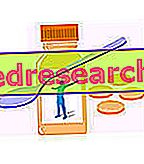Erythromycin is a drug with antibiotic action and is considered the forefather of the class of macrolides. It was first obtained from cultures of Streptomyces erythraeus .

Erythromycin - Chemical Structure
Erythromycin has a bacteriostatic type of antibiotic action, ie it does not kill bacterial cells, but inhibits their growth.
Indications
For what it uses
Erythromycin is used to treat infections caused by bacteria that are sensitive to it.
More specifically, erythromycin is indicated for the treatment of:
- Infections of the upper and lower airways and soft tissues caused by Streptococcus pyogenes ;
- Prophylaxis of bacterial endocarditis caused by Streptococcus viridans ;
- Upper and lower respiratory tract infections and otitis of the middle ear caused by Diplococcus pneumoniae ;
- Primary atypical pneumonia caused by Mycoplasma pneumoniae ;
- Acute infections of the skin and soft tissues by Staphylococcus aureus ;
- Listeria monocytogenes infections;
- Legionella pneumophila infections;
- Bordatella pertussis infections;
- erythrasma;
- Syphilis;
- Infections of the urogenital tract with Chlamydia trachomatis .
Moreover, when used in the form of gel, erythromycin is effective in the treatment of papulopustular forms of acne with a dominant inflammatory component.
Warnings
Because erythromycin is primarily metabolised by the liver, great caution should be used when administering the drug in patients with reduced liver function, in patients with renal disease and in elderly patients.
Elderly patients with hepatic and / or renal dysfunction present a greater risk of onset of ototoxicity.
Treatment with erythromycin at high doses and for a long time can cause liver damage, so regular liver function checks should be performed.
In the event of any type of allergic reaction, erythromycin treatment should be stopped immediately.
Cases of hypertrophic infantile pyloric stenosis have been reported during therapy with erythromycin in pertussis prophylaxis in children, or in the treatment of neonatal Chlamydia trachomatis infections.
Treatment with erythromycin could cause pseudomembranous colitis caused by superinfection with erythromycin-resistant bacteria itself (such as, for example, Clostridium difficile ) that are normally present in human bacterial flora. Similarly, fungal superinfections also normally present in human bacterial flora (such as Candida albicans infections ) can be favored.
Erythromycin can cause a prolongation of the QT interval (the interval of time required by the ventricular myocardium to depolarize and repolarize), including cases of arrhythmia and torsades of tip that can also be fatal, although rare.
Erythromycin could worsen the weakening of patients with myasthenia gravis (a neuromuscular disease).
Interactions
Concomitant administration of erythromycin and ergotamine or dihydroergotamine (drugs used in the treatment of migraine) can lead to an increase in the acute toxicity of ergotamine.
Simultaneous use of erythromycin and astemizole or terfenadine (antihistamine drugs) can cause serious side effects of cardiovascular type, sometimes even with fatal outcomes.
Concomitant administration of erythromycin and cisapride (a drug used to increase gastric motility), pimozide (an antipsychotic drug) or clarithromycin (another macrolide) may result in prolongation of the QT interval.
The association of erythromycin and statins (drugs used in the treatment of hypercholesterolemia) can cause rhabdomyolysis (ie the breakdown of skeletal muscle cells with consequent release into the bloodstream of substances contained in the musculature).
Erythromycin decreases the elimination rate of benzodiazepines such as, alprazolam, midazolam and triazolam, thus enhancing their pharmacological effects.
Erythromycin potentiates the effect of digoxin (a drug used to increase the strength of the heart's contraction), oral anticoagulants, theophylline (used in the treatment of bronchial asthma) and zopiclone (a hypnotic sedative drug).
Erythromycin may increase the toxicity induced by colchicine (a drug used in the treatment of gout).
Erythromycin can increase blood levels of drugs metabolized as you by cytochrome P3A4, including:
- Carbamazepine, phenytoin and valproate, antiepileptic drugs;
- Alfentanil, an opioid analgesic;
- Methylprednisolone, a glucocorticoid;
- Bromocriptine, a drug used to treat migraine;
- Quinidine, an antiarrhythmic drug;
- Vinblastine, an anticancer;
- Sildenafil, a drug used for erectile dysfunction.
Side effects
Erythromycin can trigger various types of side effects, although not all patients experience them. The type of adverse effects and the intensity with which they occur depend on the different sensitivity that each individual has towards the drug. Therefore, each person responds differently to therapy.
The following are the main adverse effects that may occur during erythromycin therapy.
Gastrointestinal disorders
Treatment with erythromycin may cause:
- Cramps and / or abdominal pains;
- Nausea;
- He retched;
- Diarrhea;
- pancreatitis;
- Anorexia;
- Pseudomembranous colitis.
Allergic reactions
Erythromycin can trigger allergic reactions in sensitive individuals. These reactions can manifest with symptoms such as rashes, hives and anaphylactic reactions.
Nervous system disorders
Erythromycin therapy can cause dizziness and convulsions.
Cardiac disorders
Treatment with erythromycin may cause prolongation of the QT interval, torsades de pointes, arrhythmias and ventricular tachycardia.
Ear disorders
Treatment with erythromycin may favor the onset of reversible deafness. Furthermore, the drug can cause tinnitus, ie an auditory disorder characterized by the perception of buzzing, hissing, jingling, whistling, etc.
Kidney and urinary tract disorders
Erythromycin therapy can cause interstitial nephritis.
Other side effects
Treatment with erythromycin can cause hepatic dysfunction and may favor the onset of confusion and hallucinations.
Changes in diagnostic tests
Erythromycin therapy may interfere with some tests for the determination of urinary catecholamines.
Overdose
The symptoms that can occur if an overdose of erythromycin is taken are:
- Epigastric pains;
- Nausea;
- Mild diarrhea;
- Cholestatic jaundice.
There is no antidote for erythromycin overdose, so the treatment is only supportive.
However, if erythromycin overdose is suspected, contact your doctor immediately or contact the nearest hospital.
Action mechanism
Erythromycin - like all macrolides - exerts its antibiotic action by interfering with bacterial protein synthesis.
Protein synthesis in bacterial cells takes place thanks to particular organelles called ribosomes.
Ribosomes consist of ribosomal RNA and proteins associated with each other to form two subunits:
- The 30S subunit, consisting of 21 proteins and one RNA molecule (16S);
- The 50S subunit, consisting of 34 proteins and two RNA molecules (23S and 5S).
The task of these organelles is to bind and translate the messenger RNA that comes from the cell nucleus and to synthesize the proteins for which it encodes.
Erythromycin binds to the 23S ribosomal RNA molecule present within the 50S subunit.
The binding of erythromycin to RNA 23S prevents RNA itself from completing protein synthesis, thereby inhibiting bacterial cell growth.
Mode of Use - Posology
Erythromycin is available in the following pharmaceutical forms:
- In the form of coated tablets, chewable tablets and granules for oral suspension for oral administration;
- In the form of gel for topical administration;
- In the form of powder and solvent for solution for injection which must be mixed just before intravenous or intramuscular administration.
Below are some indications on the doses of erythromycin usually used in therapy.
Oral administration
In adults, the dose of erythromycin usually administered is 500-1000 mg two or three times a day. Your doctor may decide to increase the dose up to a maximum of 4 g per day.
In children from 7.5 to 30 kg of body weight, the dose of erythromycin usually used is 125-500 mg three times a day.
In children from 2 to 7.5 kg of body weight, the dose of drug usually administered is 50 mg / kg of body weight per day, to be divided into three administrations.
Topical administration
Usually, erythromycin gel is applied once or twice a day according to the doctor's judgment.
Intravenous or intramuscular administration
In adults and adolescents, the dose of erythromycin usually used is 1-2 g per day, up to a maximum of 4 g per day in the case of very serious infections.
In children up to 12 years of age, the usual dose of medication is 15-50 mg / kg of body weight to be divided into several administrations throughout the day.
Pregnancy and breastfeeding
Erythromycin is able to cross the placenta and some studies have shown that newborns whose mothers took the drug in the first months of pregnancy can develop cardiovascular malformations.
Erythromycin is also excreted in breast milk.
Therefore, the use of the drug by pregnant women, or by mothers who are breast-feeding, should be performed only if it is indispensable and only under the strict control of the doctor.
Contraindications
The use of erythromycin is contraindicated in the following cases:
- Known hypersensitivity to erythromycin itself or to other macrolides;
- In patients already being treated with astemizole or terfenadine;
- In patients already on ergotamine or dihydroergotamine therapy;
- In patients who are already taking cisapride;
- In patients already being treated with pimozide.



